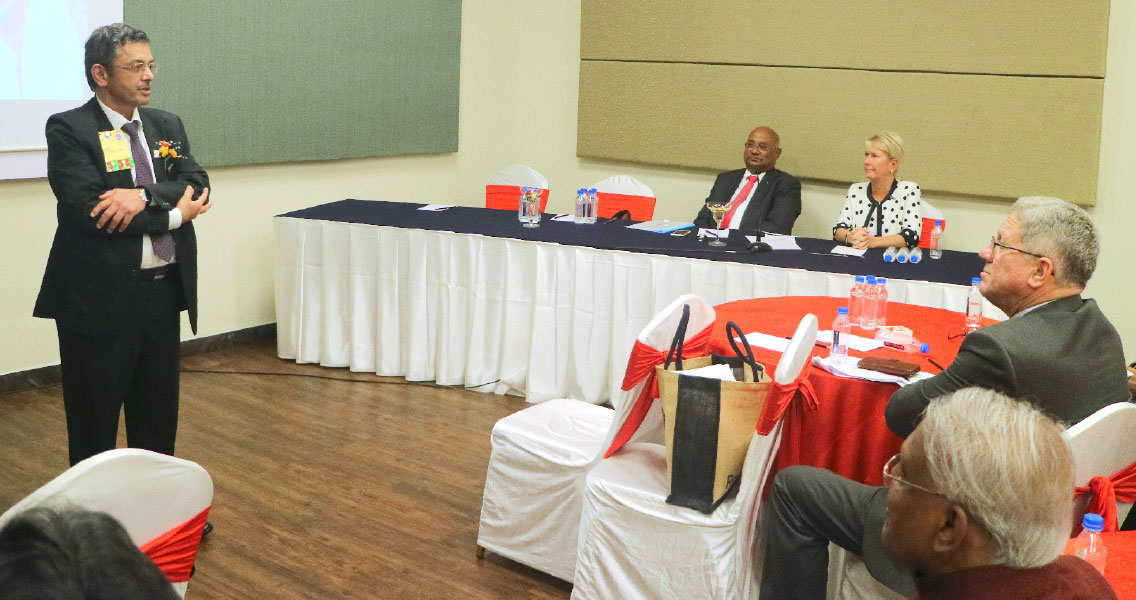
Who are the best leaders in the world and what traits would you want to emulate from them, asked PDG Deepak Kapur at a GETS training session at the Indore Institute.
A leader in any field of action must inspire and empower others, keep cool in a crisis, recognise good work, motivate and groom new leaders, said Kapur. “At the same time, one should be humble and self-confident.” While the purpose of Rotary districts is to support and strengthen clubs, they also act as a bridge between RI and Rotarians; the DGs have to strike a synergy between their clubs through fellowship and events that bond professionals from diverse backgrounds.
Those clubs that keep themselves aloof and don’t attend district events and other group activities, should be given responsibility; “involve them in training sessions and keep a watch on their monthly activities,” said Kapur.
Another challenge is to manage the conflicting leadership styles in a district hit by factionalism and power rivalry. “You should have mediation skills to overcome tussles between district leaders.”
As future governors they should devise strategies to handle conflicts and keep all the clubs working in unison for the betterment of their communities.
– INPPC Chair Deepak Kapur
Breakaway sessions discussed how to tackle conflict situations in district clubs and between district office-bearers. A clutch of problem-solving ideas were aired: a Performance Committee Chair to acknowledge the good work, or a Conflict Management Committee to go into these conflict issues; the DG can appoint a facilitator to examine issues creating problems; and the communication channels with the club’s core team must be strengthened to remove their negative perception and identity crisis.
Summing up the discussion, Kapur said as future governors they should devise strategies to handle conflicts and keep all clubs working in unison for the betterment of their communities.
Power of social media
In another session for DGEs of zones 5 and 7, PDG J B Kamdar emphasised the need to communicate and connect with clubs. Social media can be leveraged effectively to create greater impact with clubs. WhatsApp, Facebook, YouTube, Rotary.org, GML (digital), district website, email, blogs, Instagram and webinars could be used to keep Rotarians motivated to do bigger projects. “Conventional platforms such as print media, brochures, pamphlets and GML newsletters still hold relevance. Plan your OCVs (official club visits) well in advance by consulting the assistant governors, club president and secretary to know the projects they are doing, status of membership and TRF giving for a quick preview of their work,” he explained.
District website
On a scale of 1–10, how important is your district website? All DGEs agreed to a ranking of 8–9 and recommended regular updates of club events, projects and additional tools to make it easy to navigate. The club’s history, and a photo gallery could be added. DGE S Muthupalaniappan, RID 3232, said links to RI websites could be given on the district portal for sharing notes and uploading projects. DGEs Ranganath Bhat, RID 3181, Sangram Patil, RID 3170, Dr Thomas Vavanikunnel, RID 3211, and K S Venkatesan, RID 2982, agreed that district websites can become powerful digital tools to galvanise club activities and enhance fellowship.
Revamped GML
While soft copies of GML could be sent to all members, hard copies need to be posted to district leaders. Apart from district projects, the monthly newsletter must shed light on membership, TRF giving, major donations and Foundation activities with relevant figures, said Kamdar.
Continuous learning must for Regional Leaders
New priorities have replaced old strategies to increase Rotary’s impact, expand its reach, deepen the engagement of participants and enhance the ability to adapt to the tectonic changes in the world, said Nora Beamish, support staff, Regional Leaders programme, Evanston.

While the website Rotary.org is used to store training resources, the new action plan focuses on building agile teams of Regional Leaders (RRFCs, ARRFCs, EMGAs, EPNCs, DRFCs, RPICs and Trustees) who are able to develop a strong rapport with RI districts, she said at a seminar chaired by PRID C Basker at the Indore Institute. “Regional Leaders need to engage more, provide tailored information and generate ideas to keep district leadership in tune with the new realignments of RI’s focus,” said Nora. Now that Rotaractors were elevated as part of Rotary; diversity, equity and inclusion were included in the new Vision Statement of RI.
Trustee Jennifer Jones who co-chaired the session, urged the RPICs to shore up the public image of Rotary as “most people don’t know who we are and what we do.” “Regional Leaders must include Rotaractors in image building, add more women members and ensure flexibility of clubs in conducting their weekly meetings,” she added.
EPNC Dr E K Sagadhevan gave an overview of Project Positive Health — Stop NCDs, a pan-India initiative that aims to check the epidemics of obesity, hypertension and diabetes through a graded three-step approach by Rotary. “Each person must know his or her body mass index, BP and sugar levels for which clubs will issue Rotary ID cards at special NCD camps,” he said.
Apart from the Ek chammach kum, char kadam aage — One spoon less of salt, sugar and oil, take four steps forward — campaign, Rotarians will support the wellness initiatives of the governments and play a strong advocacy role, besides taking awareness programmes such as rallies, special camps and NCD sessions in schools, said Sagadhevan.
Pictures by V Muthukumaran





